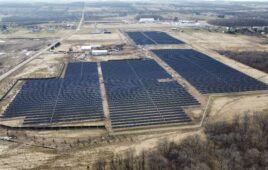
Eagle Point solar farm apiary. The beehives were moved further from the panels after this photo was taken. Credit: Pine Gate
Pollinator-friendly solar farms are growing increasingly common, but Pine Gate Renewables is taking solar farm innovation a step further with a record-setting dual use of solar farmland.
The utility-scale solar developer’s Eagle Point solar farm in Jackson County, Oregon, is the largest solar farm apiary in the United States at this time. The 9.9-MW project spans over 41 acres and uses Boviet modules, SMA inverters and Soltec trackers. On the edge of the property sits 48 honeybee hives.
When Pine Gate acquired the partially developed project, there was no plan to make the site explicitly pollinator-friendly, although the initial permitting did mention using native vegetation for groundcover. When the company kicked off its Solar Culture initiative in the summer of 2017, it looked to Eagle Point as a great dual-use candidate.
The company’s Solar Culture initiative began when CEO Zoë Gamble Hanes learned about permaculture and told Julianne Wooten, Pine Gate’s environmental manager, that she wanted to incorporate permaculture principles into Pine Gate projects.
“The whole thing is just about doing better than the status quo,” Wooten said. “Looking at each site and figuring out what makes sense for the given region, for the site conditions, and what we are able to do that can benefit the physical land itself and the community beyond the power that’s generated by the panels.”
The Solar Culture program has three pillars: sustainable agriculture, community partnerships and collaboration with various research partners. Pine Gate’s goal is to incorporate Solar Culture into any future projects where it is the EPC.
Putting pieces together
The Eagle Point project, which Wooten calls a “platinum Solar Culture site,” came together rather serendipitously. Pine Gate enlisted the help of landscape design consultant Regenerate to come up with the ambitious vegetation plan for the project. The company told the site construction contractor to avoid seeding the site with the original mix so it could move forward with its new plan instead.
Emy Maloutas, CEO of Regenerate, connected with Rob Davis, director of clean energy nonprofit Fresh Energy, in her search for the right landscape contractor. Davis happened to be looking for a solar site to connect with a beekeeper for National Pollinator Week.
After reviewing a few sites that met or exceeded the pollinator-friendly solar site scorecard developed by experts in Minnesota, Davis selected Eagle Point.
On the beekeeping side, Davis chose John Jacob, president of the Southern Oregon Beekeepers Association.
By chance, Jacob had just acquired about 400 honeybee hives from another beekeeper who was retiring. He was looking for a place to move the hives, and Eagle Point happened to be within his range, about 30 minutes from his house.
“When he told me that he was going to move 48 hives to the site, I was surprised,” said Davis, chuckling. “Because I knew that that was significantly larger than any other solar farm apiary I’d heard of at that point.”
Davis said solar apiaries are common in the U.K., but not yet in the United States.
“The idea of having local honey along with your local energy is pretty common in the United Kingdom,” Davis said. “So it’s exciting to see the practice really start to take off here in the United States.”
The collaboration is sweet for another reason—as of now, Jacob is not charged any money to keep the hives on the property. It’s a symbiotic relationship—Pine Gate gets accolades for environmental stewardship and Jacob gets free room and board for his bees.
Happy home for bees
Maloutas of Regenerate said the site is great for the bees because the long-term management of Eagle Point is rooted in sustainable land stewardship practices.
“It’s much more conscious, utilizing tools and equipment and chemicals only as necessary, and so therefore I think John also felt like the site’s long-term care goals really aligned with having bees onsite,” Maloutas said.
Forty-eight hives means a lot of honeybees, so O&M personnel working on the site should consider the possible risks associated with those insects. However, John Jacob, owner of the hives and Old Sol Apiaries, insists honeybees are quite docile.
“Typically, honeybee hives are very safe on any property,” he said. “Their stinging instinct is for nest defense, so as long as no one’s actually disturbing the hive physically, it’s very unlikely for anybody to get stung.”
Still, the hives were moved just outside the fence line, which is still within the leased area of this project, to make sure outside O&M providers did not have any issues with the bees. Pine Gate is working on developing safety agreements and protocols for the various parties that visit the site semi-regularly, with a goal of moving the hives inside the fence line once those are in place.
“It definitely adds another layer of complexity to be considered from a liability standpoint, so we’re working with a few different groups to try and figure out what best practices may look like around these situations,” Wooten said.
Jacob said he’s been excited about the dual-use land concept for a while and he sees this project as a good first step to promote the strategy.
“I feel that honeybees often get short shrift as far as forage and habitat. A lot of the best farmland around gets sucked into monocultures,” he said. “I see this model as a way for bees to get some prime managed pollinator habitat. Not just honeybees, but native bees also.”
NREL will be studying a one-acre section of the array’s pollinator-friendly habitat to educate other solar developers about what types of native plants will grow in different regions of the country as well as within different sections of a given solar site—between the panels, under them, etc. NREL has one-acre test plots at three other Pine Gate projects in Oregon and will have them at some future North Carolina sites.
Davis said he’s seeing significant interest from other major solar developers to make their projects pollinator-friendly and wouldn’t be surprised if more counties and states began adopting pollinator-friendly standards.
“The great thing about pollinator-friendly standards and scorecards is that they’re non-disruptive to the solar industry,” he said. “It’s as simple as using a different seed mix and using a different operations and management approach, as evidenced by Pine Gate’s ability to quickly pivot and take a new and innovative approach and start to bring it to scale.”
He thinks solar companies of all sizes can pretty easily implement these practices into their projects.
Jacob also thinks other industries will back pollinator-friendly solar farm standards—including fruit growers’ associations that need bees to pollinate their products and other beekeeping organizations that need pesticide-free land to house their bees.
“It will benefit so many different industries that I think there’s going to be a lot of economic support and social support for this whole concept,” he said.













Tell Us What You Think!